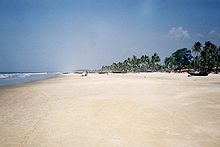Cavelossim
This article has multiple issues. Please help improve it or discuss these issues on the talk page. (Learn how and when to remove these template messages)
|
Cavelossim | |
|---|---|
village | |
UTC+5:30 (IST) | |
| PIN | 403731 |
| Vehicle registration | GA |
| Website | goa |

Cavelossim is a village in South Goa district in the state of Goa, India.
The town hosts a well-known beach at the southernmost tip of the Salcete beach stretch that starts from
History
Most of the history of Cavelossim comes from church records and from written statements by clergy originating from the village. The village was referred to as Suderbhatt or 'village of the
.The only attraction was a small temple which housed the idol of the Hindu goddess Shantadurga, believed to be located around 100 metres (330 ft) behind the current location of the church of Santa Cruz. (This temple is not to be confused with the much larger temple to the same deity in Deoolbhat, Quelossim, a similarly named village located between Mormugao and Salcete.[1])
Tradition
It is said that a usurped
It is instead believed that the Raja and his followers rather became patrons of the temple, helping it quickly became one of the largest in the region, with the manor house of descendants of the prince's followers– who are often called Rampotas or Rajpotas ('sons of King Rama') –in the temple premises. The gold coins and medallions housed by the family and church are yet to be dated and estimated.
Transition to Portuguese Goa
After the Portuguese conquest of Goa, the majority of the villagers accepted the Christian faith and the temple fell out of use, reducing it nearly to the status of a mere outbuilding of the temple family's house. This family went on to take the name of Rodrigues.
During the
Being fed by the Sal River, Cavelossim boasted lush fields and multiple fisheries which granted its communidade a hefty zonn or jono (dividend), with which the villagers were able to make sizeable donations to build a cemetery and expand the chapel to its current size. It was recognized as a separate parish church in 1948.[4] The main side gate of the church was accompanied by three pairs of pillars: the first of the church itself; the ones behind leading to the Rodrigues manor were testimony to its first patrons, who still share the back walls of the church; and the third, opposite the church, bearing lions to the erstwhile influential Gomes family, whose founder was one of the early presidente da camara de salcete following Portuguese acceptance of self-governance amongst Goans.
People and culture
Demographics
As of the 2011 India census, Cavelossim had a population of 1,955. Males constituted 51% of the population and females 49%. Cavelossim had an average literacy rate of 90.35%, higher than the national average of 74.04%: male literacy was 93.12%; and female literacy 87.56 %. The population under 6 years of age was 9.87% of the total.
Sports
As in many other Goan villages, Cavelossim's most popular sport is football.[
Geography and features
Cavelossim Beach
Cavelossim Beach is located 15 kilometres (9.3 mi) south of
References
- ^ "About: Shree Shantadurga Saunsthan". Shree Shantadurga Vijayate. Retrieved 8 January 2023.
- ISSN 1057-1515. PDF downoad
- ^ "About the temple". Shree Shantadurga Vijayate.
- ^ "Holy Cross Church, Cavelossim, Goa". Goan Churches | Information on all Churches in Goa.
- ^ "Best Beaches in Asia - 2022 Travellers' Choice Awards". Tripadvisor. 2022. Archived from the original on 7 January 2023.
- ^ "Cavelossim Beach | Goa.me". Archived from the original on 31 July 2016. Retrieved 2 August 2016.
